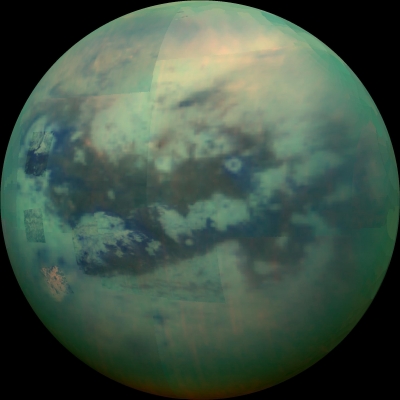
Titan is the largest moon of Saturn, the seventh planet outward from our sun. It’s the only moon in our solar system known to have a thick atmosphere, and it’s the only known body in space, besides Earth, known to have stable bodies of surface liquid. Titan has a kind of hydrological cycle, much like Earth’s, with liquids falling from the sky and flowing across this moon’s surface before evaporating back into clouds. Some of the weather phenomena we’d be familiar with on Titan include dust storms and monsoonal rains. Earth’s atmosphere is 78% nitrogen; Titan’s is 98% nitrogen. Titan’s climate is driven by seasonal change. So you can see that, in some ways, the closest comparison to Titan’s atmosphere is the one we know best: Earth’s.
But there are also many differences between Earth and this distant Saturnian moon, showing how alien and strange it would be to experience the weather on Titan.
Titan is 10 times farther from the sun than Earth and receives 100 times less solar energy. It orbits roughly in the plane of Saturn’s equator, and its tilt relative to the plane of our solar system is about the same as Saturn’s. As on Earth, Saturn’s seasons – and Titan’s – are caused by their tilts, which cause the sun to strike the different hemispheres of these worlds more strongly or more weakly throughout Saturn’s year. Saturn takes 29 years to orbit the sun once; its year is 29 Earth-years long. Thus both Saturn and Titan have seasons lasting more than 7 Earth-years.
And so any given spot on Titan experiences a change in weather at a much slower pace than on Earth.
An equinox on Titan – when both hemispheres of this moon are receiving the sun’s rays about equally – occurs about every 15 years. The last Titan equinox was in 2009. We now know – thanks to the Cassini mission to Saturn, which arrived in 2004 and lasted until 2017 – that powerful wind storms roved across Titan around the time of its 2008 equinox, producing soot that fell like rain and creating dunes on Titan’s surface.
In general, it’s now thought that Titan’s winds flow in a pole-to-pole circulation for some 12 Earth years before taking a few years to transition to the opposite direction as winter changes to summer.
Credit : EarthSky
Picture Credit : Google




